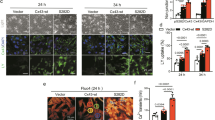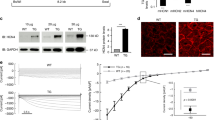Abstract
The plasma membrane protein the Na+/H+ exchanger isoform1 (NHE1) has been implicated in various cardiac pathologies including ischemia/reperfusion damage to the myocardium and cardiac hypertrophy. Levels of NHE1 protein and activity are elevated in cardiac disease; however, the mechanism by which these factors contribute to the accompanying hypertrophy in the myocardium is still not clear. To investigate the mechanism of NHE1-induced hypertrophy in the myocardium we constructed two adenoviral vectors expressing either wild type NHE1 protein or a constitutively active NHE1 protein. Infection of neonatal rat ventricular cardiomyocytes (NRVM) resulted in elevated expression of both wild type NHE1 or constitutively active NHE1. Only expression of activated NHE1 protein resulted in an increase in cell size and in an increase in protein synthesis in isolated cardiomyocyte cells. The results demonstrate that expression of activated NHE1 promotes cardiac hypertrophy in isolated cardiac cells and that simple elevation of levels of wild type NHE1 protein does not have a significant hypertrophic effect in NRVM. The results suggest that regulation of NHE1 activity is a critical direct effector of the hypertrophic effect induced in the myocardium by the NHE1 protein.





Similar content being viewed by others
Abbreviations
- HA:
-
Hemagglutinin
- NHE:
-
Na+/H+ exchanger
- NRMVs:
-
Neonatal rat ventricular cardiomyocytes
References
Fliegel L, Wang H (1997) Regulation of the Na+/H+ exchanger in the mammalian myocardium. J Mol Cell Cardiol 29:1991–1999
Fliegel L (2001) Regulation of myocardial Na+/H+ exchanger activity. Basic Res Cardiol 96:301–305
Cingolani HE, Ennis IL (2007) Sodium-hydrogen exchanger, cardiac overload, and myocardial hypertrophy. Circulation 115:1090–1100
Malo ME, Fliegel L (2006) Physiological role and regulation of the Na+/H+ exchanger. Can J Physiol Pharmacol 84:1081–1095
Fliegel L, Dyck JRB, Wang H, Fong C, Haworth RS (1993) Cloning and analysis of the human myocardial Na+/H+ exchanger. Mol Cell Biochem 125:137–143
Avkiran M (2001) Protection of the ischaemic myocardium by Na+/H+ exchange inhibitors: potential mechanisms of action. Basic Res Cardiol 96:306–311
Karmazyn M, Sawyer M, Fliegel L (2005) The Na(+)/H(+) exchanger: a target for cardiac therapeutic intervention. Curr Drug Targets Cardiovasc Haematol Disord 5:323–335
Karmazyn M, Sostaric JV, Gan XT (2001) The myocardial Na+/H+ exchanger: a potential therapeutic target for the prevention of myocardial ischaemic and reperfusion injury and attenuation of postinfarction heart failure. Drugs 61:375–389
Harris C, Fliegel L (1999) Amiloride and the Na+/H+ exchanger protein. Mechanism and significance of inhibition of the Na+/H+ exchanger. Int J Mol Med 3:315–321
Kemp G, Young H, Fliegel L (2008) Structure and function of the human Na+/H+ exchanger isoform1. Channels (Austin) 2:329–336
Avkiran M, Cook AR, Cuello F (2008) Targeting Na+/H+ exchanger regulation for cardiac protection: a RSKy approach? Curr Opin Pharmacol 8:133–140
Liao R, Force T (2007) Not all hypertrophy is created equal. Circ Res 101:1069–1072
Cingolani HE, Camilion de Hurtado MC (2002) Na(+)–H(+) exchanger inhibition: a new antihypertrophic tool. Circ Res 90:751–753
Marban E, Koretsune Y (1990) Cell calcium, oncogenes, and hypertrophy. Hypertension 15:652–658
Clerk A, Sugden PH (1999) Activation of protein kinase cascades in the heart by hypertrophic G protein-coupled receptor agonists. Am J Cardiol 83:64H–69H
Ennis IL, Escudero EM, Console GM, Camihort G, Dumm CG, Seidler RW, Camilion de Hurtado MC, Cingolani HE (2003) Regression of isoproterenol-induced cardiac hypertrophy by Na+/H+ exchanger inhibition. Hypertension 41:1324–1329
Besson P, Fernandez-Rachubinski F, Yang W, Fliegel L (1998) Regulation of Na+/H+ exchanger gene expression: mitogenic stimulation increases NHE1 promoter activity. Am J Physiol 274:C831–C839
Gan XT, Chakrabarti S, Karmazyn M (1999) Modulation of Na+/H+ exchange isoform 1 mRNA expression in isolated rat hearts. Am J Physiol 277:H993–H998
Dyck JRB, Maddaford T, Pierce GN, Fliegel L (1995) Induction of expression of the sodium-hydrogen exchanger in rat myocardium. Cardiovascular Res 29:203–208
Karmazyn M, Liu Q, Gan XT, Brix BJ, Fliegel L (2003) Aldosterone increases NHE-1 expression and induces NHE-1-dependent hypertrophy in neonatal rat ventricular myocytes. Hypertension 42:1171–1176
Yokoyama H, Gunasegaram S, Harding SE, Avkiran M (2000) Sarcolemmal Na+/H+ exchanger activity and expression in human ventricular myocardium. J Am Coll Cardiol 36:534–540
Moor A, Gan XT, Karmazyn M, Fliegel L (2001) Activation of Na+/H+ exchanger-directed protein kinases in the ischemic and ischemic-reperfused rat myocardium. J Biol Chem 27:16113–16122
Fliegel L, Karmazyn M (2004) The cardiac Na-H exchanger: a key downstream mediator for the cellular hypertrophic effects of paracrine, autocrine and hormonal factors. Biochem Cell Biol 82:626–635
Engelhardt S, Hein L, Keller U, Klambt K, Lohse MJ (2002) Inhibition of Na(+)–H(+) exchange prevents hypertrophy, fibrosis, and heart failure in beta(1)-adrenergic receptor transgenic mice. Circ Res 90:814–819
Yoshida H, Karmazyn M (2000) Na(+)/H(+) exchange inhibition attenuates hypertrophy and heart failure in 1-wk postinfarction rat myocardium. Am J Physiol 278:H300–H304
Chen L, Gan XT, Haist JV, Feng Q, Lu X, Chakrabarti S, Karmazyn M (2001) Attenuation of compensatory right ventricular hypertrophy and heart failure following monocrotaline-induced pulmonary vascular injury by the Na+–H+ exchange inhibitor cariporide. J Pharmacol Exp Ther 298:469–476
Marano G, Vergari A, Catalano L, Gaudi S, Palazzesi S, Musumeci M, Stati T, Ferrari AU (2004) Na+/H+ exchange inhibition attenuates left ventricular remodeling and preserves systolic function in pressure-overloaded hearts. Br J Pharmacol 141:526–532
Counillon L, Pouyssegur J (2000) The expanding family of eukaryotic Na+/H+ exchangers. J Biol Chem 275:1–4
Mraiche F, Oka T, Gan XT, Karmazyn M, Fliegel L (2011) Activated NHE1 is required to induce early cardiac hypertrophy in mice. Basic Res Cardiol 106:603–616
Sardet C, Franchi A, Pouysségur J (1989) Molecular cloning, primary structure, and expression of the human growth factor-activatable Na+/H+ antiporter. Cell 56:271–280
Slepkov ER, Rainey JK, Li X, Liu Y, Cheng FJ, Lindhout DA, Sykes BD, Fliegel L (2005) Structural and functional characterization of transmembrane segment IV of the NHE1 isoform of the Na+/H+ exchanger. J Biol Chem 280:17863–17872
Slepkov ER, Chow S, Lemieux MJ, Fliegel L (2004) Proline residues in transmembrane segment IV are critical for activity, expression and targeting of the Na+/H+ exchanger isoform1. Biochem J 379:31–38
Ding J, Rainey JK, Xu C, Sykes BD, Fliegel L (2006) Structural and functional characterization of transmembrane segment VII of the Na+/H+ exchanger isoform1. J Biol Chem 281:29817–29829
Xia Y, Javadov S, Gan TX, Pang T, Cook MA, Karmazyn M (2007) Distinct KATP channels mediate the antihypertrophic effects of adenosine receptor activation in neonatal rat ventricular myocytes. J Pharmacol Exp Ther 320:14–21
Coccaro E, Karki P, Cojocaru C, Fliegel L (2009) Phenylephrine and sustained acidosis activate the neonatal rat cardiomyocyte Na+/H+ exchanger through phosphorylation of amino acids Ser770 and Ser771. Am J Physiol Heart Circ Physiol 297:H846–H858
Coccaro E, Mraiche F, Malo M, Vandertol-Vanier H, Bullis B, Robertson M, Fliegel L (2007) Expression and characterization of the Na(+)/H(+) exchanger in the mammalian myocardium. Mol Cell Biochem 302:145–155
Bertrand B, Wakabayashi S, Ikeda T, Pouyssegur J, Shigekawa M (1994) The Na+/H+ exchanger isoform1 (NHE1) is a novel member of the calmodulin-binding proteins. J Biol Chem 269:13703–13709
Imahashi K, Mraiche F, Steenbergen C, Murphy E, Fliegel L (2007) Overexpression of the Na+/H+ exchanger and ischemia-reperfusion injury in the myocardium. Am J Physiol Heart Circ Physiol 292:H2237–H2247
Xue J, Mraiche F, Zhou D, Karmazyn M, Oka T, Fliegel L, Haddad GG (2010) Elevated myocardial Na+/H+ exchanger isoform1 activity elicits gene expression that leads to cardiac hypertrophy. Physiol Genomics 42:374–383
Chan AY, Soltys CL, Young ME, Proud CG, Dyck JR (2004) Activation of AMP-activated protein kinase inhibits protein synthesis associated with hypertrophy in the cardiac myocyte. J Biol Chem 279:32771–32779
Zahabi A, Deschepper CF (2001) Long-chain fatty acids modify hypertrophic responses of cultured primary neonatal cardiomyocytes. J Lipid Res 42:1325–1330
Wang H, Singh D, Fliegel L (1997) The Na+/H+ antiporter potentiates growth and retinoic-acid induced differentiation of P19 embryonal carcinoma cells. J Biol Chem 272:26545–26549
Michalak M, Fliegel L, Wlasichuk K (1990) Isolation and characterization of calcium binding glycoproteins of cardiac sarcolemmal vesicles. J Biol Chem 265:5869–5874
Iaccarino G, Dolber PC, Lefkowitz RJ, Koch WJ (1999) Bbeta-adrenergic receptor kinase-1 levels in catecholamine-induced myocardial hypertrophy: regulation by beta- but not alpha1-adrenergic stimulation. Hypertension 33:396–401
Fujita T, Noda H, Ito Y, Isaka M, Sato Y, Ogata E (1989) Increased sympathoadrenomedullary activity and left ventricular hypertrophy in young patients with borderline hypertension. J Mol Cell Cardiol 21(Suppl 5):31–38
Tzeng J, Lee BL, Sykes BD, Fliegel L (2010) Structural and functional analysis of transmembrane segment VI of the NHE1 isoform of the Na+/H+ exchanger. J Biol Chem 285:36656–36665
Meima ME, Mackley JR, Barber DL (2007) Beyond ion translocation: structural functions of the sodium-hydrogen exchanger isoform-1. Curr Opin Nephrol Hypertens 16:365–372
Li X, Karki P, Lei L, Wang H, Fliegel L (2009) Na+/H+ exchanger isoform1 facilitates cardiomyocyte embryonic stem cell differentiation. Am J Physiol Heart Circ Physiol 296:H159–H170
Okamoto H (2007) Osteopontin and cardiovascular system. Mol Cell Biochem 300:1–7
Schellings MW, Pinto YM, Heymans S (2004) Matricellular proteins in the heart: possible role during stress and remodeling. Cardiovasc Res 64:24–31
Singh M, Ananthula S, Milhorn DM, Krishnaswamy G, Singh K (2007) Osteopontin: a novel inflammatory mediator of cardiovascular disease. Front Biosci 12:214–221
Singh M, Foster CR, Dalal S, Singh K (2009) Osteopontin: role in extracellular matrix deposition and myocardial remodeling post-MI. J Mol Cell Cardiol 48:538–543
Singh M, Foster CR, Dalal S, Singh K (2010) Osteopontin: role in extracellular matrix deposition and myocardial remodeling post-MI. J Mol Cell Cardiol 48:538–543
Acknowledgments
This study was supported by the Canadian Institutes of Health Research #MOP-97816. Larry Fliegel is supported by an Alberta Heritage Foundation for Medical Research Senior Scientist award.
Author information
Authors and Affiliations
Corresponding author
Rights and permissions
About this article
Cite this article
Mraiche, F., Fliegel, L. Elevated expression of activated Na+/H+ exchanger protein induces hypertrophy in isolated rat neonatal ventricular cardiomyocytes. Mol Cell Biochem 358, 179–187 (2011). https://doi.org/10.1007/s11010-011-0933-z
Received:
Accepted:
Published:
Issue Date:
DOI: https://doi.org/10.1007/s11010-011-0933-z




